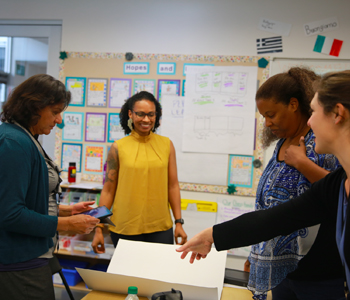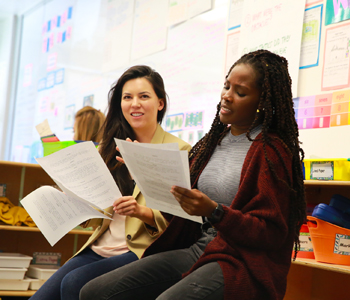Creating a High School School Culture that Believes in Kids
By Ryan Gallagher and Peter A’Hearn- CSTA President Elect
Do you believe your students can do challenging work and think about complex ideas? Do your colleagues and staff share this belief?

The Next Generation Science Standards (NGSS) expect students to do the work of scientists and engineers such as making and revising models, arguing from evidence, and designing experiments. If we don’t think our students are capable of independent thinking, these goals are impossible.
I’ve worked in many high schools with teams of teachers. High schools are diverse and one of the ways in which they differ most strongly is in their culture around believing in students abilities. There are schools in which the dominant attitude is, “These kids can’t do that.” There are other schools where teachers strongly believe that, with the right support, students can solve difficult problems and understand challenging concepts and there are a range of schools in between. I have been particularly struck by the culture of teachers within the High Tech High system of schools. I have rarely heard teachers there express anything but a positive belief in students’ ability.
High Tech High is an independent charter organization based in San Diego, consisting of elementary, middle, and high schools spread across four campuses and sixteen schools. I decided to ask Ryan Gallager, Director of Continuous Improvement, about how High Tech High received its positive culture and how it keeps it.
Pete: I’ve noticed that in High Tech High, there is almost a universal attitude of, “Let’s figure out how to help our students do this.” You’ve been a part of this culture for a long time. What’s going on here?
Ryan: Let me start by saying that we are not perfect and there are many things related to culture that we are working on.
There are two things that I think are important. One is the “How?” How do we maintain a positive culture? We have structures that are intentional about that maintenance. Then there is the “Why?” Why do we work on these structures? And that “Why?” is for me around equity being one of our design principles.
Equity is not just about having representative scientists in the back of the classroom, which is important. It’s more about being diverse by design and meeting student’s needs. It’s about constantly talking to students in elementary, middle, and high school. Students have no problem telling you how they feel. So we engage in collaborative design which is this conversation with kids about the science and what they are bringing to the table and what they already know. I feel like that is what NGSS aspires to be.

Our culture is built around the strong belief that all students are capable of producing meaningful work that they are proud of, engaging in thoughtful debates with each other and experts in the community, and solving real problems in the world.
Pete: Those things sound great, but how do you get there and how do you maintain it?
Ryan: Yeah, so it’s not just something that just happens. It can go off the rails a little bit. So I think it’s all about maintaining a positive adult learning community. If we are mirroring the behaviors we expect for our students, if teachers are collaborating, if they are having positive meeting structures, if they are using protocols and doing work that matters, if we can create that for adults, then we can make it happen for students. I also think it starts at the top. Our site leaders treat their teachers like the professionals that teachers truly are. This means giving teachers more agency in designing and implementing their unique project designs.
Pete: I’d like to unpack this a bit. You are using the term, “We.” Who is “we?”
Ryan: High Tech High is very lean as far as a district is concerned. We have small schools of about 300 students with a director. There are no district initiatives beyond our four design principles. We expect the director to know their staff well and there is a huge amount of trust. We hired you to teach science and do the best for your kids and we trust you to do that.
Pete: It feels like there is a natural tendency in schools to complain about kids. Maybe society in general. Adults like to complain about kids. It’s like where entropy takes it. How do you fight against that?
Ryan: It starts with hiring the right people and with the interview process. There are always kids as part of the interview. We do a student panel where students have a hand in who we hire. Candidates teach a model lesson that is observed by other teachers at the site. We have candidates read an article about equity and discuss with other candidates to notice how they talk about kids and interact with other adults. We are looking for adults who want to be part of a learning community.
The key for me is how are we modeling a positive adult learning community.
Pete: I’m wondering about time in all of this. Lots of conversations with kids, lots of conversations with adults. It sounds like it takes time. I think of always being stretched for time and trying to grade papers and then going to a staff meeting and trying to squeeze some grading into that.
Ryan: This is where we lose most people. We have morning meetings. School starts at 8:30am and teachers get to school at 7:30am. It varies by site but typically Monday and Friday is our teaching team meetings. At the high school and middle school for example, that’s a science teacher paired with a humanities teacher, math/science teacher and often an exploratory subject (language, arts, etc). That might be to talk with each other and talk to kids. Wednesday is often a project tuning meeting. They get feedback on a project by talking with kids or adults. They might look at student work, or engage in collaborative planning or meet with an inclusion specialist to support our students with IEPs. Tuesdays are traditional staff meeting while Thursdays alternate between discipline meeting and action groups (which kind of mirror PLCs).
It’s really key that when we talk about student work, we use norms and protocols to keep the discussion productive. It helps model how we talk about kids or student work.
Pete: What are some of the key ideas in that protocol that keep it positive?
Ryan: Strong facilitation is a key. Making sure we hear from everyone, so nobody dominates. “Step up, Step back” which means that if you normally speak, you make sure to back off and listen and we find ways to invite people who don’t say as much to be active in the conversation.
People tend to hate protocols, but after a dozen times it clicks. “This really works!” The people who really hate protocols are often the people that the protocol is designed to contain. I know this all too well because I used to be one of these people. Protocols have really helped push me to listen more to students and colleagues rather than just thinking about the next thing I want to say.
Pete: Yeah, I think often when we do norming work, people think, “This is a waste of time, don’t we have work to do?” But the norming is what really allows for that culture to exist.
Ryan: The protocol if its very tight. We have a thirty-five minute protocol that keeps the conversations very tight and feels very productive.
Pete: How often do you bring students into these conversations?
Ryan: It depends from school to school, but I would say, most of the time. We had students at High Tech High Chula Vista who took a conventional tuning protocol and turned it into a protocol to look at Culturally Relevant Teaching. They took an existing protocol and added an equity lens to it and they facilitated it with adults.
Pete: Does the project-based nature of your schools help with this? The goal is not to learn this and pass the test, but to have every student produce a product that is worthy of showcasing. Does that shift in goals change the way teachers have to think about student work?
Ryan: Absolutely, because project-based learning has a couple things built in to it. One is the audience. Who is this being done for? It’s not just my teacher. It elevates the purpose. Also in project based learning there is a real project. I remember in high school getting my worksheets and scantrons back and just throwing them away. In project based learning you create something that has value, and that’s motivating for the student and that becomes motivating for the teacher.
Pete: I know that some people reading this are going to think, “This is so pie in the sky. This is so far removed from what school is.” In most schools, there is a test and everything is tied to how students do on the test. How can a teacher in a regular school help cultivate a positive culture?
Ryan: Teaching is hard to do alone. It’s better to do with a group. So you can start with one-on-one conversations about why you like science and why you like teaching. Remember to enjoy the craft of teaching and the craft of science. If we think of teaching as a craft, it’s about working with others and working on improvement. To use the craft analogy, it’s not about making the right chair. No craftsman thinks they are making the perfect chair. It’s all about getting better and enjoying the work that you do.
At any level if you’re feeling like your culture is not where you want it for students or adults, it starts with a conversation about craft.
Below are additional resources discussed in the interview if you want to dig deeper.
School Reform Initiative - Protocols
Share Your Learning
Podcast, project cards and more - Unboxed
Ryan Gallagher is the Director of Continuous Improvement at High Tech High Schools





